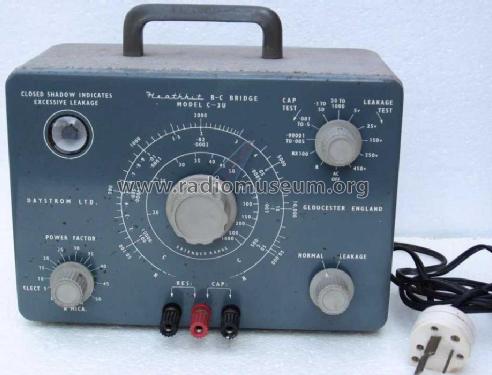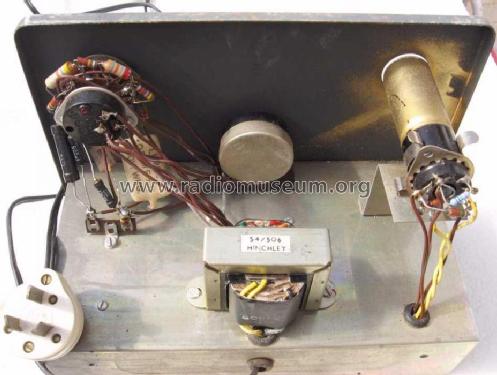R-C Bridge C-3U
Heathkit (UK) by Daystrom
- Produttore / Marca
- Heathkit (UK) by Daystrom
- Anno
- 1952 ??
- Categoria
- Strumento da laboratorio
- Radiomuseum.org ID
- 134270
- Numero di tubi
- 1
- Valvole
- EM34
- Gamme d'onda
- - senza
- Tensioni di funzionamento
- Alimentazione a corrente alternata (CA) / 220 Volt
- Altoparlante
- - - Nessuna uscita audio.
- Materiali
- Mobile di metallo
- Radiomuseum.org
- Modello: R-C Bridge C-3U - Heathkit UK by Daystrom
- Forma
- Soprammobile con qualsiasi forma (non saputo).
- Dimensioni (LxAxP)
- 245 x 175 x 130 mm / 9.6 x 6.9 x 5.1 inch
- Annotazioni
- Meßbrücke für Widerstände und Kondensatoren mit Lecktest
- Peso netto
- 2.8 kg / 6 lb 2.7 oz (6.167 lb)
- Fonte dei dati
- - - Data from my own collection
- Autore
- Modello inviato da Rolf Nickel. Utilizzare "Proponi modifica" per inviare ulteriori dati.
- Altri modelli
-
In questo link sono elencati 55 modelli, di cui 53 con immagini e 26 con schemi.
Elenco delle radio e altri apparecchi della Heathkit (UK) by Daystrom
Discussioni nel forum su questo modello: Heathkit UK by: R-C Bridge C-3U
Argomenti: 1 | Articoli: 1
Dear friends,
I bought this test equipment from New Zealand. The former owner stated, that the "Magic eye works as it should" and "It's a 240 V equipment", and that he had no further opportunities of checking it.
At the beginning of each maintenance work one should be sure about the correct supply voltage. Therefore I observed the rear of the magic eye.
A funny thing - somebody tried to "refurbish" it by spraying golden paint on the tube including part of the rear of the front panel. Because I was not sure if the told value of the mains voltage was correct, I had to find out which type of magic eye it is. See the result of my "investigative cleaning" - I felt like a CSI policeman in TV : A Mullard EM 34, an european tube type with 6,3 V heater voltage.
Next steps: Removal of the selenium rectifier (the EM 34 was already removed), mounting of a new mains plug and then connecting with 230V AC. Now 6,6 VAC could be measured between the both yellow heater wires. The information of the seller was right and the transformer okay, at least the heating winding.
Now the selenium rectifier was replaced by an 1N 4007 and 220 Ohms in series, and the old UK 8 µF electrolytic capacitors (Dubilier Drilitic BR) were replaced by two new 10 µF types. After that I plugged in the EM 34, and connected the tester with mains voltage again. One has to be very cautious because the high voltages including mains can be easily touched. There is no insulation round the contacts of the "CAP TEST" switch at the upper right side of the front panel.
And then I switched on. After a few seconds of waiting for a short circuit or similar the magic eye became green, and both main voltages, - 500 V (!) and + 150 V could be measured in parallel of the new electrolytic capacitors. The negative voltage seems a little bit too high in comparison with the schema value of - 410 V, but ± 20 % are allowed, and our mains voltage is about 230 VAC.
On the left side of the front panel is printed "Closed shadow indicates excessive leakage" above the magic eye.
But what is meant with "Closed shadow" ? - Figure 2 or Figure 3 ? I think it this as shown in the Figure 2 below, "without shadow". Am I right or not ?

Then I connected a reference mica capacitor 10 nF ± 0,3 % which I bought from the "desert company", and the result was good: One full and one half shadow were reached precisely and very near to the 0,01 line !

I will continue my report ... (finally, the rain stops).
Best regards
Rolf
Allegati
- Technical_data_sheet_C-3 (23 KB)
Rolf Nickel, 23.Aug.08


